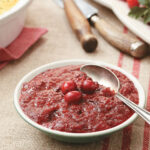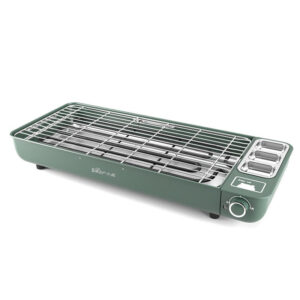Pepper sauce enthusiasts and spice lovers are always on the hunt for the world’s spiciest peppers, pushing their taste buds to fiery extremes. Before we delve into the world of super spicy pepper sauce, let’s first explore the scientific principles behind pepper heat and how we measure it using the Scoville scale.
The Scoville Scale and Pepper Heat
Before embarking on the journey of crafting super spicy pepper sauce, it’s essential to grasp the fundamentals of pepper heat. The Scoville scale, developed by pharmacist Wilbur Scoville in 1912, serves as the standard measure for assessing the spiciness or pungency of peppers. Scoville Heat Units (SHU) quantify the concentration of capsaicin, the compound responsible for the fiery sensation in peppers.
The World's Hottest Peppers



Now that we have the Scoville ratings as our reference point, let’s explore some of the spiciest peppers discovered worldwide. These peppers are renowned not only for their heat but also for their unique flavors and cultural significance.
Carolina Reaper: The Reigning Champion
The Carolina Reaper pepper holds the Guinness World Record for the spiciest pepper, with an average heat exceeding 1.6 million SHU, a staggering figure. Its distinctive wrinkled appearance and fruity undertones make it the top choice for those seeking extreme heat.
Trinidad Moruga Scorpion: The Fiery Foe
The Trinidad Moruga Scorpion, native to Trinidad and Tobago, is another heavyweight contender in the world of super spicy peppers. With its menacing, stinger-like tail and intense heat, it has earned a reputation as one of the world’s spiciest peppers.
Ghost Pepper: Legendary Heat
Also known as Bhut Jolokia, the Ghost Pepper once held the title of the world’s spiciest pepper before being surpassed by the Carolina Reaper. Its searing heat and slightly smoky flavor have made it a favorite among pepper enthusiasts.
Beyond Record Holders: More Incendiary Varieties
As the Carolina Reaper, Trinidad Moruga Scorpion, and Ghost Pepper take the spotlight, several other peppers closely follow suit. Varieties like the 7 Pot Primo, Dragon’s Breath, and Naga Viper continue to push the boundaries of spiciness.
Crafting Super Pepper Sauce
Crafting super spicy pepper sauce is an art form that requires a delicate balance between choosing the right peppers, incorporating complementary flavor-enhancing ingredients, and mastering the cooking process. Let’s take a closer look at each step to ensure your sauce delivers both scorching heat and outstanding flavor.
Selecting the Right Peppers
Of course, the foundation of any super spicy pepper sauce is the peppers themselves. The choice of peppers will significantly influence the sauce’s heat level and flavor characteristics. To create a memorable super hot sauce, consider the following factors:
Pepper Varieties: As discussed earlier, peppers like the Carolina Reaper, Trinidad Moruga Scorpion, and Ghost Pepper are renowned for their heat. Mixing different varieties can provide your sauce with a more complex and layered spiciness. For instance, combining Carolina Reaper peppers with Ghost Peppers can offer extreme heat and a hint of smokiness.
Fresh vs. Dried Peppers: While using fresh peppers is common, some sauce makers prefer dried peppers. Dried peppers can impart a more concentrated and robust flavor. If using dried peppers, soak them in warm water before blending to rehydrate them.
Seeds and Membranes: The seeds and membranes inside peppers contain the highest concentration of capsaicin, the compound responsible for heat. Adding some seeds and membranes will increase the sauce’s spiciness. However, be cautious not to overdo it, as this can make the sauce excessively hot.

Complementary Flavor-Enhancing Ingredients
While the primary goal of super spicy pepper sauce is to deliver intense heat, achieving a balanced flavor profile is equally important. Here are some key ingredients that can enhance the sauce’s taste without compromising its fiery nature:
Vinegar: Vinegar provides acidity to the sauce, aiding in preservation and enhancing flavor. White vinegar and apple cider vinegar are common choices. The type of vinegar you select will impact the overall flavor of the sauce, so experiment to find one that suits your taste.
Garlic: Roasted or fresh garlic cloves can provide a rich, earthy base for your sauce. Its robust flavor complements the intense heat of the peppers.
Sweeteners: To balance the heat and acidity, you can add sugar, honey, or fruit as sweeteners. These ingredients create a harmonious contrast with the fiery peppers, making the sauce more appealing to a broader audience.
Salt: Do not underestimate the importance of salt in super spicy pepper sauce. It not only enhances the overall flavor but also acts as a natural preservative.
Fruit: Fruits like mangoes, pineapples, or peaches can add sweetness and a touch of tropical flair to your sauce. They pair well with the super-hot peppers and contribute to a more complex flavor profile.
The Cooking Process: From Peppers to Sauce
The transformation from a pile of super spicy peppers to a smooth and delicious sauce requires a carefully planned cooking process.
Prepare the Peppers: Start by chopping the peppers and removing the stems. If you want to intensify the heat, you can retain some or all of the seeds and membranes. Place the peppers in a blender along with the other selected ingredients. Begin with a small amount of liquid, typically vinegar, to facilitate blending. Gradually add more liquid as needed to achieve the desired sauce consistency.
Simmer Over Low Heat: Transfer the blended mixture to a saucepan and simmer over low heat. This step serves several purposes: it can meld flavors, thicken the sauce, and aid in its preservation. Stir occasionally to prevent burning and ensure even cooking.
Strain: Once the sauce has simmered to perfection, it’s time to strain it. Use a fine-mesh sieve or a coarse cloth to remove any solids, leaving a smooth and silky sauce. This step not only improves the texture but also ensures even distribution of heat. However, if you wish to retain some texture, you can skip the straining.
Bottling: Choose a sealed glass bottle to maintain freshness. Allow the sauce to cool before bottling to prevent the glass from shattering.
Aging: Many hot sauce enthusiasts believe in the benefits of aging. Allowing the sauce to sit in a cool, dark place for several weeks or even months can mellow the flavors and blend them together, creating a more harmonious sauce.
Safety and Handling of Super Spicy Peppers
Handling super spicy peppers like the Carolina Reaper, Trinidad Scorpion, or Ghost Pepper requires special attention to safety to prevent any accidents or discomfort. These peppers are among the spiciest in the world and contain high concentrations of capsaicin, the compound responsible for their heat. Here are some basic safety and operational tips:
Wear Gloves: When handling super spicy peppers, be sure to wear disposable gloves. Capsaicin can easily transfer to the skin, causing intense burning and irritation even with minimal contact. Nitrile gloves are preferable as they offer better protection compared to latex gloves.
Protect Your Eyes: Wear safety goggles or glasses to shield your eyes from accidental splashes of pepper juice. Capsaicin entering the eyes can be extremely painful and may temporarily impair vision.
Avoid Touching Your Face: When handling super spicy peppers, be mindful not to touch your face, especially your eyes, nose, or mouth. Thoroughly wash your hands with soap and water before touching your face or any other sensitive areas.
Ventilation: Ensure good kitchen ventilation when cutting, slicing, or using super spicy peppers. Capsaicin fumes can irritate the respiratory system and may lead to coughing or discomfort.
Prevent Cross-Contamination: Be cautious when cleaning up after handling super spicy peppers. Thoroughly wash all utensils, cutting boards, and countertops with soap and water to prevent capsaicin residue.
Minimize Direct Contact: If you intend to taste or cook with super hot peppers, consider using kitchen tongs or a fork to handle them instead of your hands. This minimizes contact and reduces the risk of contamination.
Start Slow: When cooking with super spicy peppers, start with a small amount and taste as you go. You can always add more heat, but it’s challenging to reduce the heat if it becomes too intense.
Milk or Dairy Products: If you accidentally consume super spicy peppers and feel discomfort, consume dairy products such as milk, yogurt, or ice cream. The fat in dairy can help alleviate the burning sensation by binding with capsaicin.
Stay Hydrated: Drink plenty of water, but remember that water cannot alleviate the burning caused by capsaicin. It may temporarily soothe your mouth, but dairy products are more effective.
Handle with Care: After handling super spicy peppers, carefully remove your gloves, avoiding external contact. Dispose of them properly and wash your hands thoroughly.
Seek Medical Attention: In extremely rare cases of severe discomfort, burning, or allergic reactions, seek immediate medical attention. Allergic reactions to capsaicin are rare but can be serious.
Popular Super Spicy Pepper Sauce Recipes
Now that you’ve learned the basics of crafting super spicy pepper sauce, it’s time to delve into some popular recipes that are revered among chili enthusiasts and hot sauce connoisseurs. Each of these recipes offers unique flavors and a fiery fusion to elevate your culinary creations to a whole new level.
Classic Carolina Reaper Sauce
Begin your hot sauce journey with this classic dish based on the Carolina Reaper. This sauce combines the scorching heat of Carolina Reapers with some complementary ingredients to create a sauce that is not only hot but also flavorful.
Ingredients:
10-12 Carolina Reaper peppers
4 cloves of garlic
1 cup white vinegar
1 teaspoon salt
1 tablespoon sugar (optional for sweetness)
Instructions:
Prepare the Peppers: Remove the stems from the Carolina Reaper peppers and roughly chop them. You can choose to keep or discard the seeds and membranes based on your desired heat level.
Blend with Garlic: Place the chopped peppers, garlic cloves, vinegar, salt, and sugar (if desired) in a blender. Blend until you achieve a smooth consistency.
Boil and Strain: Transfer the mixture to a saucepan and bring it to a boil. Simmer for 10-15 minutes, stirring occasionally to prevent sticking or burning. After boiling, strain the sauce to remove any solids.
Bottle and Cool: Allow the sauce to cool, then transfer it to a sealed glass bottle. Refrigerate for maximum freshness.

Spicy Mango Pineapple Sauce
For those who enjoy adding a fruity twist to their spiciness, this mango pineapple sauce strikes a perfect balance between sweet and spicy. It’s an excellent condiment for grilled meats, fried corn cakes, and tropical dishes.
Ingredients:
6-8 Scotch Bonnet peppers
1 ripe mango, peeled and diced
1 cup pineapple chunks
2 cloves of garlic
1/2 cup white vinegar
1 teaspoon salt
1 tablespoon honey
Instructions:
Prepare the Peppers: Remove the stems and seeds from the Scotch Bonnet peppers, then roughly chop them. You can retain some seeds for extra heat if desired.
Blend with Fruits: In a blender, combine the peppers, diced mango, pineapple chunks, garlic cloves, white vinegar, salt, and honey. Blend until smooth.
Boil and Strain: Pour the mixture into a saucepan and simmer for about 15 minutes. Stir regularly to prevent sticking. After simmering, strain the sauce to remove any fruit fibers and seeds.
Cool and Bottle: Let the sauce cool before transferring it to a glass container. Store it in the refrigerator to maintain freshness.
Smoky Ghost Pepper BBQ Sauce
Elevate your barbecue game with this smoky ghost pepper BBQ sauce. It combines the intense heat of ghost peppers with smokiness and savory flavors, making it the perfect companion for grilled meats and burgers.
Ingredients:
5-6 ghost peppers
1 onion, chopped
3 cloves of garlic, minced
1 cup tomato sauce
1/2 cup brown sugar
1/4 cup apple cider vinegar
2 tablespoons Worcestershire sauce
1 tablespoon liquid smoke
1 teaspoon salt
Instructions:
Prepare the Ghost Peppers: Remove the stems, seeds, and membranes from the ghost peppers. Chop them.
Sauté the Aromatics: In a saucepan, sauté the chopped onion and minced garlic until they become translucent.
Mix the Ingredients: Add the chopped ghost peppers, tomato sauce, brown sugar, apple cider vinegar, Worcestershire sauce, liquid smoke, and salt to the saucepan. Stir well.
Boil and Blend: Simmer the mixture over low heat for about 20-25 minutes, stirring occasionally. Once the sauce thickens and the flavors meld, remove it from heat. Use an immersion blender or regular blender to blend the sauce until smooth.
Cool and Store: Allow the sauce to cool before transferring it to glass bottles or jars. Refrigerate to maintain freshness.
To keep your homemade sauces fresh, store them in a cool, dark place. When storing multiple sauces, label them clearly to avoid any confusion. Include the production date and a brief description of the sauce’s flavor profile and heat level.
Enjoying Super Spicy Pepper Sauces
Now that you’ve made super spicy pepper sauces, it’s time to savor their fiery deliciousness. Knowing how to serve and enjoy them can greatly enhance your culinary experience. Let’s explore the best practices for incorporating these spicy delights into your diet.

Pairing Pepper Sauce with Food
The versatility of super spicy pepper sauces means they can elevate the flavor of various dishes. Here are some fantastic pairings to make the most of your homemade sauces:
Grilled Meats: Pepper sauce, especially those with smoky or fruity flavors, pairs exceptionally well with grilled meats. Whether you’re enjoying juicy steaks, tender chicken, or succulent pork, a drizzle of pepper sauce can add depth and heat.
Fried Corn Cakes and Mexican Tacos: Add a touch of pepper sauce to enhance your Mexican-inspired dishes. Corn cakes, tacos, and fried cornmeal patties benefit from the contrast between the sauce’s heat and the coolness of sour cream and avocado salsa.
Burgers and Sandwiches: Spice up your burgers and sandwiches with a fiery kick. Smoky pepper sauces can complement the flavors of beef, chicken, or veggie patties beautifully.
Seafood: If you’re a seafood enthusiast, consider adding some heat. Shrimp, scallops, and fish tacos can be taken to a new level with spicy pepper sauce.
Soups and Stews: Turn soups and stews into spicy comfort food. A few drops of homemade sauce can add complexity to chili, tomato soup, bean stew, and more.
Pizza: On your next pizza night, bring out your pepper sauce collection. Drizzle it over slices for a delicious kick that will leave a lasting impression on your taste buds.
Using Chili Sauce in Cooking
Chili sauce is not just a condiment; it’s also a flavor enhancer. It can be the secret ingredient that transforms your recipes.
Marinades: Mix the sauce with olive oil, garlic, and herbs to create spicy meat marinades. Let the proteins soak in the flavors before cooking.
Salad Dressing: Add a few drops of the sauce to your salad dressing for a spicy kick. It pairs well with citrus and honey-based dressings.
Stir-Fries: Incorporate chili sauce into your stir-fry sauce mixture to add flavor. It can provide a delightful kick to your veggies and proteins.
Sauces and Dips: Use chili sauce as a base for spicy pasta sauces, curry dishes, or as a fiery dip for chips and snacks.
Exploring Super Spicy Sauce Culture: The Chili Eating Challenge
The chili eating challenge is not for the faint of heart. These competitions feature a selection of super hot peppers, some of which may be among the hottest in the world. Varieties like the Carolina Reaper, Trinidad Moruga Scorpion, and Ghost Pepper are common contenders. These peppers contain extremely high levels of capsaicin, the compound responsible for their intense heat.
Each challenge has its own set of rules, but the objective is simple: eat the peppers without immediate relief. Participants typically have a time limit to endure the intense heat. During challenges, drinking milk or any other cooling substance is often prohibited.
Chili eating challenges are often conducted in front of audiences, whether at food festivals, competitive eating events, or even on social media platforms. Audiences are drawn to these challenges, witnessing participants’ intense reactions.
Successful completion of a chili eating challenge may lead to recognition, bragging rights, and sometimes even prizes. However, the immediate aftermath can be quite challenging, with participants experiencing severe discomfort, including stomachaches and digestive issues.
In summary, making super spicy pepper sauces is an art form that allows you to explore the outer limits of cooking heat and flavor. Embrace the challenge and savor the fiery deliciousness these peppers bring.
Frequently Asked Questions
Q1: Can I adjust the spiciness of chili sauce?
Yes, you can customize the heat level of the sauce by adjusting the type and quantity of peppers used. Experiment with different combinations to find the spiciness you enjoy.
Q2: Are there health benefits to eating super spicy chili peppers?
Moderate consumption of super spicy chili peppers is associated with potential health benefits, such as improved metabolism and pain relief. However, excessive consumption can lead to digestive discomfort.
Q3: How should homemade super spicy chili sauce be stored?
Homemade chili sauce can be stored in a sealed container in the refrigerator for several months. Proper sealing and refrigeration help maintain its flavor and heat.
Q4: What dishes pair well with super spicy chili sauce?
Super spicy chili sauce can enhance a variety of dishes, including grilled meats, fried corn cakes, stir-fries, and even pasta. Use it as a condiment or ingredient to elevate your favorite recipes.
Q5: Can super spicy chili sauce be used as a marinade?
Absolutely! Super spicy chili sauce makes an excellent marinade for both meats and vegetables. During the marinating process, the heat and flavor infuse into the food, creating irresistible results.
































